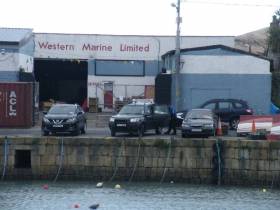Displaying items by tag: Development Plans
In the southwest, the Bantry Bay Port Company is working with community groups to consider further developments at the Abbey pier area and the tidal slob area in the inner harbour with the Royal Institute of Architects of Ireland (RIAI).
That’s revealed in the Port of Cork Company’s annual report for 2021, which shows strong financial performance.
Combined, the Ports of Cork and Bantry reported a total consolidated traffic throughput of 10.6m tonnes last year. However, throughput at the Whiddy Island oil storage facility in Bantry declined significantly (62%).
There was an 18% increase in turnover from €33.7m in 2020 to €39.8m in 2021. The company’s profits also increased, with an operating gain of €7.8m (€6.1m in 2020).
The Southern Star has further coverage here.
Councillor Urges DLRCC to Turn Down Plans in Bulloch Harbour, Dalkey
#DublinBay - A Councillor has urged Dun Laoghaire Rathdown County Council to reject the latest plans for Bulloch Harbour, Dalkey, writes the Dublin Gazette.
Councillor Michael Merrigan (Ind) has called on council planners to reject the current planning application for a mixed use development on the historic south Dublin Bay harbour pier.
Councillor Merrigan said he had considered in detail the planning application, drawings and reports lodged by the applicant with Dun Laoghaire Rathdown County Council, which Afloat adds took place just days before Christmas.
Afloat also adds that the mixed development lodged to DLCC by Bartra Property is for marine commercial, leisure/community and residential buildings.
A public meeting organised by Save Bulloch Harbour, led by Bulloch Harbour Preservation Association, is to be held next Tuesday, 23 January, for further details see photo-caption above.
As the Dublin Gazette continues, original plans were rejected in February last year after almost 300 residents lodged complaints about the proposal.
Cllr Merrigan said: “The current development proposal submitted to the planning authority is inappropriate for Bulloch Harbour.
“It fails to address, the unique sense of place and maritime heritage and character of the area, which needs to be protected and sensitively enhanced as a coastal amenity.
“As a local county councillor for the area I am disappointed that no progress has been made on a master plan for the harbour.”
Cllr Merrigan said he had a number of concerns over the new plan.
He said that it was an inappropriate development for the area and added that it would have a negative impact on the existing fishing boat hire services.
To read more on the development, click here.
Revised Plan to Be Filed Today for Bulloch Harbour, Dalkey Development
#BullochPlans - Today, new plans are to be filed for a residential and commercial development in picturesque Bulloch Harbour, Dalkey, 10 months after a similar, controversial scheme was refused permission.
As The Irish Times writes, Bartra Capital Ltd, founded by developer Richard Barrett, will submit a revised vision for the small fishing harbour which includes a cafe, “marine leisure” facilities, detached houses and apartments.
The developer says it has taken seven months to consider the views of stakeholders and local residents and believes it has arrived at a “very good scheme”.
However, the Bulloch Harbour Preservation Association (BHPA), which rallied support for a campaign of opposition last January, says despite the new plans having “a nod” toward the community, further opposition is almost certain.
The previously unsuccessful bid prompted public meetings and was ultimately rejected by Dún Laoghaire Rathdown County Council in February.
Although planning will officially be lodged today, a site notice appeared at the harbour yesterday afternoon, outlining the plan.
It has scaled back the residential aspect from nine overall units to five, made up of three detached houses and two apartments.
For more about local concerns, click the newspaper's coverage here.






























































